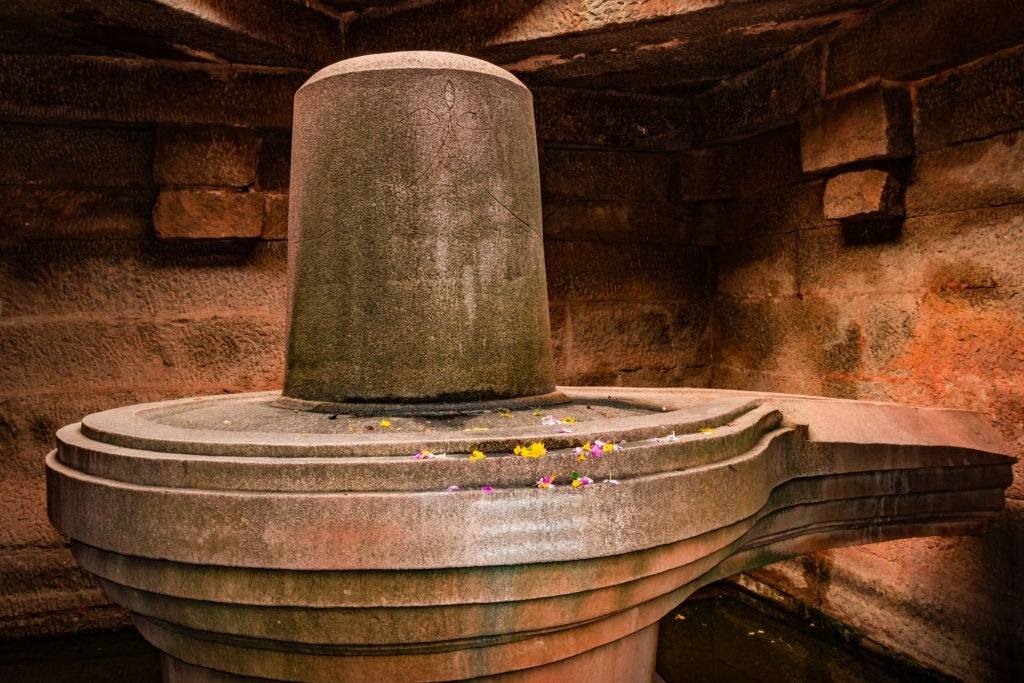Shiva Lingam, The Origin, and Reason Why Lord Shiva is worshipped in This Form

Lord Shiva is among the most respected deities in Hinduism and is part of the ‘Trinity of Gods’ that includes Lord Vishnu and Lord Brahma. He is worshipped in both human form and a form known as Lingam. However, the devotees mostly worship Lord Shiva in the form of Linga or Lingam. So what is the context behind the linga worship of Lord Shiva?
This representation of Shiva is most recognizable to Hindus for their worship and ritual is known as the lingam. The word lingam means a “sign” or distinguishing mark. Thus says the Linga Purana–“The distinctive sign by which one can recognize the nature of something is called lingam.”
The Shiva Lingam origin in Mythology

Based on the Shiva Purana and Vishnu Purana there is an interesting story behind the Linga worship. The renowned sage Bhrigu, who was one of the seven great sages, the Saptarshis, one of the many Prajapatis (the facilitators of Creation) created by Lord Brahma once ventured to the abode of Lord Shiva.
He wanted to discuss some important spiritual matters with him. However, after reaching his abode he knocked the door of Shiva’s residence. There was no immediate reply. He knocked again, this time a little louder. No avail.
The knocking turned to heavy striking, and then to a desperate beating. Finally, Shiva appeared, taking his own time. He had his wife Parvati on his left arm.
Clearly, the supreme lord had thought it appropriate to first complete his engagement with the goddess, rather than immediately redirect his attention to the respected ascetic.
Infuriated at the treatment meted out to him, the sage cursed Shiva that henceforth, since he was so fond of making love, he would be worshipped in the image of his organ of generation, rather than his anthropomorphic representation.
Thus, to this day, Shiva is worshipped in the form of the male organ of procreation, often alone, and frequently connected with the corresponding female organ, which is sculpted as a container to receive Shiva’s seed mostly made of stones.
You May Also Like: 10 Amazing Stories about Lord Shiva
The other variations on the use of Lingam for Shiva worship
Apart from the above story in the Puranas, there are other variations on the origin of this symbol of Lord Shiva, some of which ascribe a complex and intellectual origin to it.
For example, when Shiva is visualized as the intangible primordial Creative Power, the lingam is said to be his representation which can be worshipped by his followers, who require a tangible object to focus their prayers on.
This stream of thought however does not deny the phallic connotations of the lingam. Its literal meaning as a distinguishing mark links these two interpretations. Consider a newborn male child. What is the sign which distinguishes its sex?
Thus, the phallus is the lingam, the symbol of Shiva’s manhood, and of which the human organ is just a microcosmic reflection.
Another legend describes why the lingam is believed to be one of the most potent emblems in Hindu ideals. It all started with Lord Brahma and Vishnu, who were debating over their relative supremacy.
Their arguments were interrupted by a superluminous glow from a strange and blazing pillar, its shape was similar to the lingam. Both of them sped towards this indescribable bright light, which grew before their eyes into infinity, piercing the earth and extending through the heavens.
Overwhelmed and shocked by the mysterious vision, the two gods decided to seek the beginning and end of this burning immensity.
Brahma took the form of a swan flew upwards, and Vishnu dove down acquiring the shape of a boar. Both of the gods, however, could not understand the extent of this fiery column at either end and returned exhausted and confused.
At that moment, the central part of the pillar split open and Shiva revealed himself in his full glory. Overawed, both Brahma and Vishnu bowed before him. Thunderous laughter, or the sound of AUM, issued from the pillar, filling the sky.
It now became clear that the glowing, flaming lingam was a pillar of fire, connecting heaven and earth. It had no end and no beginning, but it had direction, upwards, as does the earthly fire.
In metaphysical terms, it was (is), the vertical axis that both holds apart and joins heaven and earth, dividing and uniting them at the same time, an apt symbol of cosmic integrity. Like the Tree of Life, it is both the foundation and support that ensures equilibrium between heaven and earth.
You May Also Like: Hindu Philosophy and Modern Science Amazing Similarities
In Vedic hymns, Rudra (an epithet for Shiva) is identified with Agni, who in these sacred texts is deified as the carrier of the sacrificial offerings to the gods for whom they are intended. Hence, Agni is the mediator between men and gods, and acts as a metaphysical bridge between the two, just like the cosmic lingam.
An appropriate observation here is that every creative process is accompanied by the generation of heat. In that context, the sexual act is nothing but the offering of the seed of life into the sacred fire of love.
Hence, Agni, the God of Fire, is eminently suited as a metaphoric emblem of the Tejas (creative heat) of Shiva, both metaphysically and physically.
In this setting, it is interesting to note that in temples where the linga is worshipped, there is often a conical pot, kept hanging over it.
At the bottom of this vessel is a small hole, from which water drips continuously. The idea is to cool the ‘fiery’ lingam. In the shrine, Shiva is eternally in the embrace of the goddess.
By entering the sacred enclosure we are, in a sense, interrupting his amours. Thus water is poured to stifle the hotheaded god’s temper. Shiva is Bhairava (quick-tempered), but he is also Ashutosh (One who calms down quickly). Indeed, a devotee needs to calm his god before asking for favors.
You May Also Like: Kedarnath Yatra: Amazing Spiritual Destinations of India
Another description of the origin of the lingam gives a more sensuous portrayal

According to this view, there once lived in a forest, a group of hermits with their wives. At some point in time, Shiva ventured their way, resplendent in his naked glory. The noble wives, the very epitomes of chastity, lost all their moral reservations and went wild with desire at the sight of his tempting body.
In addition to their restraint, they also shed their inhibitions, ornaments, and clothes, and embraced this naked stranger in a wild, uncontrolled frenzy.
In one version, the forest sages gave a similar curse to Shiva as Sage Bhrigu in the mythological context mentioned above. A second source says that naturally angered by this unabashed display of passion by their better halves, they snatched out Shiva’s phallus and threw it on the ground. In a sacred twist to the tale, it is believed that it broke into twelve pieces when it struck the earth, and at each of the spots a pilgrimage centre sprung up.
These twelve sacred sites are today known as the ‘Twelve Jyotirlingas,’ and are important destinations in the itinerary of a Shaivite pilgrim. The word Jyotirlinga itself means a ‘linga of light,’ thus further cementing the association of Shiva’s phallus with the cosmic pillar of light.
Yet another legend says that the severed lingam of Shiva proved to be proverbially too hot to handle. Falling to the ground, it did not come to rest, but moved about, burning anything and everything that came in its way. Even the combined efforts of all the gods could not restrain its fierce fieriness. Finally, it was Mother Earth, whom the lingam penetrated, who managed to quench it inside her womb.
In this regard, it must also be stressed here that though Shiva is visualized as an ithyphallic deity, his true message is not a license to licentiousness.
Shiva’s erect organ connotes the very opposite in this context. It stands for ‘seminal retention,’ and represents complete yogic control of the senses. Shiva’s linga is always vertical, pointing upwards as the phallus of an accomplished yogi, with the semen (Sanskrit Virya) rising, rather than discharging itself.
Here a parallel is drawn with the uncoiled energy of kundalini, which rises and climbs the length of its path. Indeed the vertical is the direction of the sacred; it is a symbol of ascent, pointing to heaven and transcendent regions. The spermatozoid substance when reabsorbed through sexual abstinence, nourishes the cerebral matter. Rising, according to yogic formula, through the subtle channels flanking the backbone, it renders the intellectual faculties more acute.
The Yogi perceives sexual energy as though it were coiled up at the base of the spine, which is why it is called kundalini (coiled) and likened to a sleeping snake.
When utilizing mental concentration, it awakens and unwinds its coils, it rises like a column of fire toward the zenith, toward the top of the skull, and pierces it to reach the transcendent worlds. Shiva’s liberated phallus represents this illuminating power rising heavenward beyond the material world.
Thus is the linga likened to a pillar of light, guiding us to true knowledge.
You May Also Like: Maha Shivaratri: Why do we celebrate, Significance and Rituals
The two images of Lord Shiva
Images of Shiva are of two kinds — iconic (anthropomorphic) and aniconic. The former represents Shiva as a human being while the latter envisages an abstract origin for him. In this manner is Shiva different from all other deities.
The images of all other deities bestow only sensuous enjoyment since they are invariably represented in an anthropomorphic form, appealing solely to the sense organs.
But Shiva grants both enjoyment and spiritual release. As an icon, he has the body of man, but in his aniconic form, he is visualized as the cosmic pillar. Yet this pillar also evokes his phallus. As an abstract shape, the pillar symbolizes a purely conceptual reality that cannot be sensed in material terms.
Visually, however, the shape of the cylindrical pillar with a rounded top resembles that of the phallus. Also when the time came for Shiva to reveal himself to both Brahma and Vishnu, he did so in the form of a lingam.
Thus the lingam is an object of the greatest sanctity, more sacred than any anthropomorphic image of Shiva. Not surprisingly thus, the innermost sanctuary of all Shiva temples is reserved for the lingam, while the outer precincts of the sacred architecture may show him in his human form.
Indeed, though his iconic images abound, no such image ever occupies the center of attention in a Shiva temple, this honor is reserved exclusively for Shiva’s lingam.











